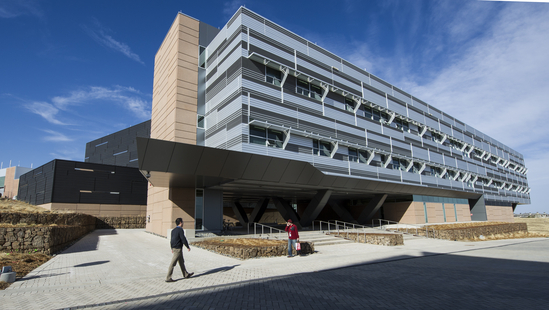 Photovoltaic panels on high performance buildings can significantly cut energy costs and carbon emissions. But distributed, intermittent renewable energy sources are a challenge to integrate with the aging U.S. electrical grid. The vital goal of a smarter, more resilient national energy system moved closer on September 11, with the dedication of the Energy Systems Integration Facility (ESIF) in Golden, Colorado. The 182,500-square-foot ESIF complex houses about 200 scientists and engineers, 15 electricity, thermal and fuel laboratories, a sustainable office building, outdoor testing sites, and a petascale computer (1 quadrillion calculations per second) and data center. An interconnecting feature is the Research Electrical Distribution Bus, a system that allows megawatt-scale integration testing in real-time simulations. Congress recognized the need for a user facility to scale-up clean energy technologies when it provided $135 million for construction in 2010.
Photovoltaic panels on high performance buildings can significantly cut energy costs and carbon emissions. But distributed, intermittent renewable energy sources are a challenge to integrate with the aging U.S. electrical grid. The vital goal of a smarter, more resilient national energy system moved closer on September 11, with the dedication of the Energy Systems Integration Facility (ESIF) in Golden, Colorado. The 182,500-square-foot ESIF complex houses about 200 scientists and engineers, 15 electricity, thermal and fuel laboratories, a sustainable office building, outdoor testing sites, and a petascale computer (1 quadrillion calculations per second) and data center. An interconnecting feature is the Research Electrical Distribution Bus, a system that allows megawatt-scale integration testing in real-time simulations. Congress recognized the need for a user facility to scale-up clean energy technologies when it provided $135 million for construction in 2010.
ESIF is the latest high-tech addition to the 327-acre campus of the National Renewable Energy Laboratory (NREL). The Department of Energy-funded, contractor-operated NREL is dedicated to applied research on energy efficiency and renewable energy. Known as the Solar Energy Research Institute during the Carter administration, the institute’s generous budget was slashed during Ronald Reagan’s tenure, and funding has fluctuated ever since. In 1991, the institute was renamed NREL and designated a national laboratory by the DOE. Operated by MRIGlobal and managed by the Alliance for Sustainable Energy, NREL includes research facilities for photovoltaics, biomass, solar cells, thin films and nanotechnologies, plus land-based and offshore wind at the National Wind Technology Center in Boulder. DOE-set energy policies shape NREL research priorities, and have resulted in numerous awards for transferring renewable and efficiency technologies and innovations to the marketplace. Notably, taxpayer-funded NREL works with private partners to evaluate technologies before implementation to reduce financial and other risks of adoption. Risk-reduction through state-of-the-art testing is also a fundamental aim of ESIF, given the complexities of integrating renewables such as intermittent wind power into current systems of energy generation, transmission, distribution and use.
ESIF’s first industry partner, Advanced Energy Industries of Colorado, is developing less expensive, more efficient solar power inverters that will facilitate a more diverse energy mix. Other integration research priorities include:
- Building and facility systems;
- Community power generation and microgrids;
- Utility generation;
- Renewable energy-sourced grids; and
- Energy efficiency technologies.
Energy Secretary Ernest Moniz toured ESIF as part of the dedication ceremony. In the visualization center, Moniz donned 3-D glasses to observe simulated airflow patterns in wind turbine arrays and, at the data center, ceremonially pressed a button to launch ESIF’s supercomputer. Called Peregrine, the high performance computer will allow modeling of material properties, industrial processes and full-scale integrated systems that would be prohibitively expensive or too dangerous for real-world testing. Developed by NREL in collaboration with Hewlett Packard, Peregrine will support all of NREL’s efforts to develop more efficient and cost effective clean energy technologies.
In remarks at the dedication, Secretary Moniz emphasized rapid recent progress in developing renewable and efficient energy technologies. Many of the latest advances are incorporated into the ESIF facility itself. Energy Star-rated equipment, evaporative-based central cooling and transfer of electrical energy between laboratory experiments for reuse, using the Research Electrical Distribution Bus, all contribute to ESIF’s sustainability. Especially notable is the use of waste heat from Peregrine and the data center to warm the building in Colorado winters, a system that Hewlett-Packard is now commercializing. With a “whole building” green design and electricity use monitored down to plug loads, ESIF is expected to earn LEED-Platinum, the U.S. Green Building Council’s highest rating.
ESIF, said Moniz, will catalyze the inclusion of existing and emerging technologies into buildings, cities and the nation’s energy system. Industry and utilities will use the facility to develop and test new equipment and strategies more rapidly and thoroughly than is possible at any other laboratory. Lab-proven advances are essential to swift deployment of an energy infrastructure that can withstand the vicissitudes of a changing climate and incorporate distributed energy from sun, wind and tides as reliably as from fossil-fuel power plants. Said Moniz, ESIF “will be a major focus of DOE to help us transform the energy system to the one we need in 2030.”
